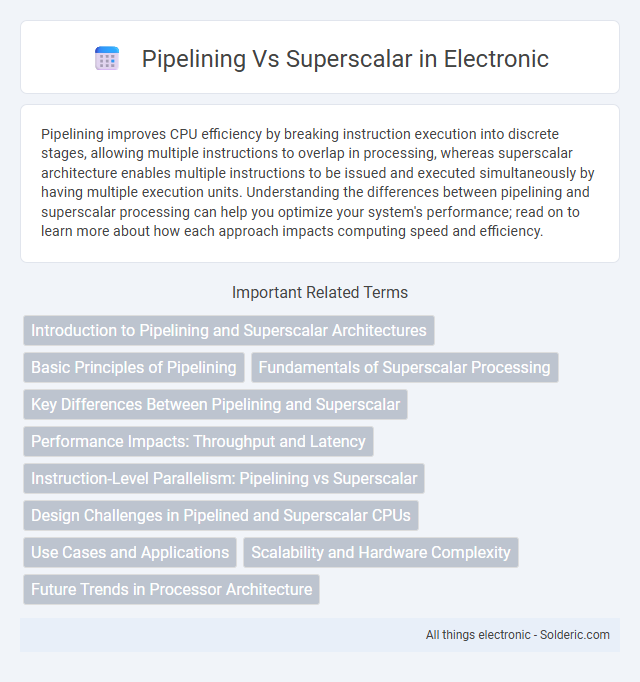Pipelining improves CPU efficiency by breaking instruction execution into discrete stages, allowing multiple instructions to overlap in processing, whereas superscalar architecture enables multiple instructions to be issued and executed simultaneously by having multiple execution units. Understanding the differences between pipelining and superscalar processing can help you optimize your system's performance; read on to learn more about how each approach impacts computing speed and efficiency.
Comparison Table
| Feature | Pipelining | Superscalar |
|---|---|---|
| Definition | Technique that divides instruction execution into stages for parallel processing | Processor design that issues multiple instructions per clock cycle |
| Instruction Execution | One instruction per stage simultaneously | Multiple instructions issued and executed simultaneously |
| Parallelism Type | Instruction-level pipelining | Instruction-level parallelism (ILP) |
| Hardware Complexity | Moderate complexity with pipeline registers | High complexity with multiple functional units and issue logic |
| Performance Gain | Increases throughput by overlapping instruction stages | Increases throughput by issuing multiple instructions per cycle |
| Hazard Handling | Pipeline stalls and forwarding | Dynamic scheduling and out-of-order execution |
| Example Processors | MIPS Pipeline | Intel Pentium, AMD Ryzen |
Introduction to Pipelining and Superscalar Architectures
Pipelining improves processor throughput by dividing instruction execution into discrete stages, allowing multiple instructions to overlap in different phases simultaneously. Superscalar architectures enhance performance further by enabling multiple instructions to be issued and executed in parallel within a single clock cycle. Both approaches aim to maximize CPU efficiency but differ in complexity and hardware requirements, with pipelining focusing on sequential step overlap and superscalar on parallel instruction issue.
Basic Principles of Pipelining
Pipelining improves processor throughput by dividing instruction execution into multiple overlapping stages, allowing a new instruction to enter the pipeline at each clock cycle. Each stage handles a distinct step such as fetching, decoding, executing, or writing back, enabling efficient parallelism within a single instruction stream. This approach reduces the instruction cycle time by breaking down operations into smaller, manageable segments processed concurrently.
Fundamentals of Superscalar Processing
Superscalar processing fundamentally involves the ability to issue multiple instructions per clock cycle by leveraging parallel execution units, unlike pipelining which focuses on breaking down instruction execution into sequential stages. By exploiting instruction-level parallelism through dynamic scheduling, superscalar architectures achieve higher throughput and improved CPU performance. Key elements include multiple dispatch units, reorder buffers, and sophisticated hazard detection to efficiently manage concurrent instruction flows.
Key Differences Between Pipelining and Superscalar
Pipelining improves processor throughput by dividing instruction execution into sequential stages, allowing multiple instructions to overlap in execution, whereas superscalar architecture executes multiple instructions simultaneously by dispatching them to multiple functional units. Pipelining relies on instruction-level parallelism within a single thread, while superscalar exploits parallelism by issuing several instructions from the instruction stream per clock cycle. The key difference lies in pipelining's linear stage progression versus superscalar's wide-issue capability to enhance overall CPU instruction throughput.
Performance Impacts: Throughput and Latency
Pipelining improves throughput by overlapping instruction execution stages, allowing multiple instructions to be processed simultaneously, which reduces latency per instruction cycle. Superscalar architectures further enhance throughput by issuing multiple instructions per clock cycle from multiple execution units, significantly increasing instruction-level parallelism. Your system's overall latency benefits from pipelining's stage efficiency, while superscalar designs reduce instruction bottlenecks, maximizing both throughput and performance.
Instruction-Level Parallelism: Pipelining vs Superscalar
Instruction-level parallelism (ILP) in pipelining allows multiple instruction stages to overlap, executing different parts of several instructions simultaneously to improve throughput. Superscalar architecture extends ILP by issuing and executing multiple instructions per clock cycle using multiple execution units, significantly increasing performance beyond pipeline restrictions. While pipelining improves instruction flow sequentially, superscalar designs exploit higher parallelism by handling multiple instructions in parallel, enhancing ILP capacity and CPU efficiency.
Design Challenges in Pipelined and Superscalar CPUs
Design challenges in pipelined CPUs primarily involve handling data hazards, control hazards, and ensuring efficient pipeline stage balancing to maximize instruction throughput. Superscalar CPUs face added complexities such as dynamic instruction scheduling, register renaming, and branch prediction to enable the simultaneous execution of multiple instructions per cycle. Both architectures require intricate hardware mechanisms to manage dependencies and resource conflicts while minimizing stalls and maintaining high performance.
Use Cases and Applications
Pipelining is widely used in embedded systems and microcontrollers where predictable instruction flow and power efficiency are crucial, such as in automotive control units and consumer electronics. Superscalar architectures excel in high-performance computing environments, including gaming consoles and servers, by executing multiple instructions per clock cycle to maximize throughput. Your choice depends on balancing complexity with performance needs, where pipelining offers simplicity and energy savings, while superscalar designs deliver superior processing speed for demanding applications.
Scalability and Hardware Complexity
Pipelining enhances scalability by dividing instruction execution into discrete stages, allowing multiple instructions to overlap and maintain steady throughput with relatively simple hardware. Superscalar architectures improve performance by issuing multiple instructions per cycle through parallel execution units, increasing scalability but significantly raising hardware complexity due to the need for sophisticated instruction scheduling, dependency checking, and resource allocation. The trade-off centers on pipelining's moderate complexity with predictable scalability versus superscalar's aggressive performance gains balanced by intricate hardware design and higher power consumption.
Future Trends in Processor Architecture
Future trends in processor architecture emphasize integrating advanced pipelining techniques with superscalar designs to maximize instruction throughput and minimize latency. Increasing core counts and enhanced branch prediction algorithms enable processors to execute multiple instructions per cycle more efficiently, addressing the limitations of traditional pipelining alone. Your computing performance will benefit as emerging architectures blend deep pipelines with parallel superscalar execution, optimizing power efficiency and processing speed for complex workloads.
pipelining vs superscalar Infographic

 solderic.com
solderic.com